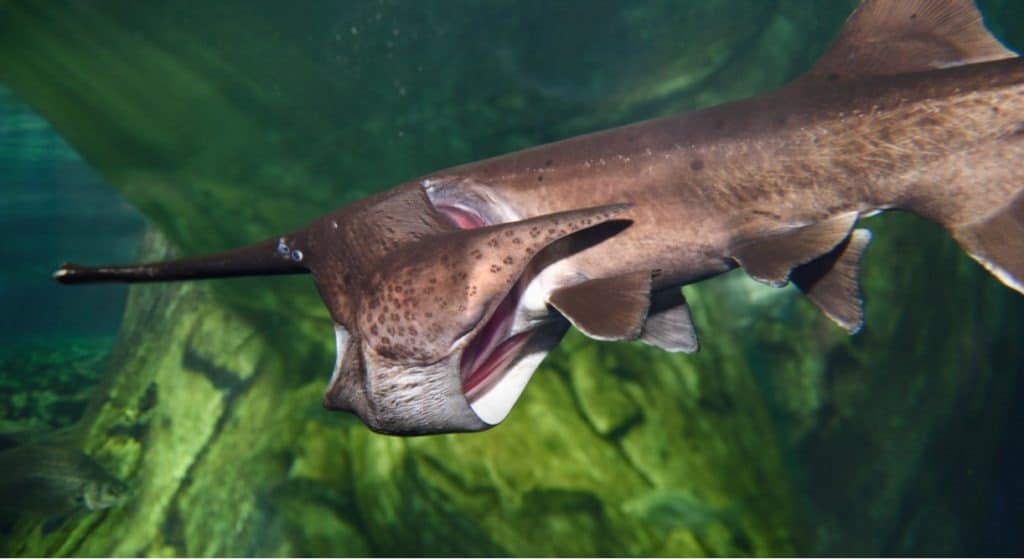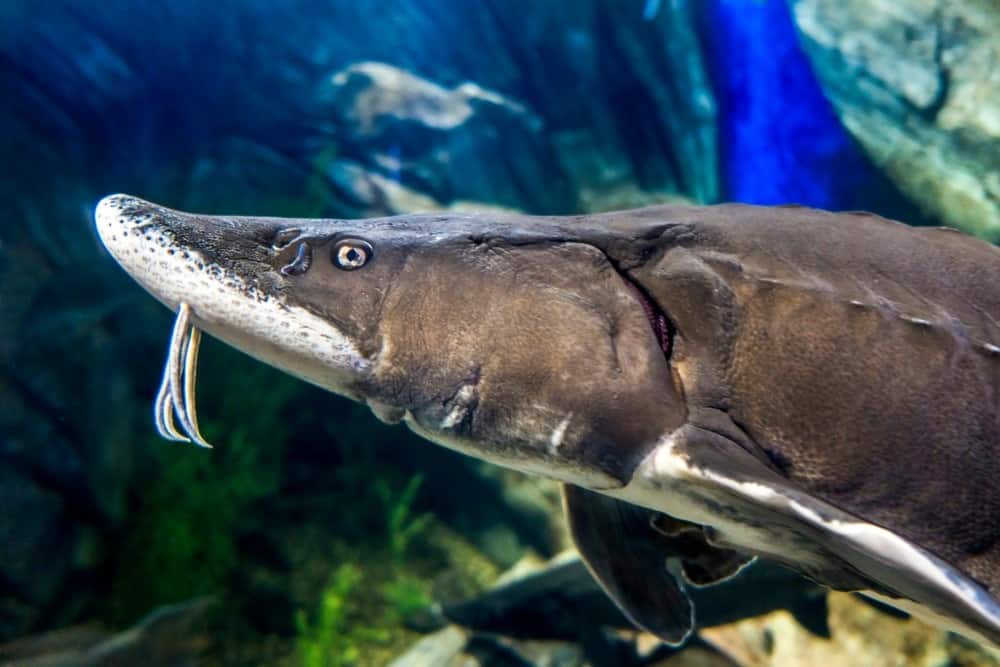Paddlefish, so named because of their oar-like snouts, aren’t sturgeon, but they’re similar enough to be considered cousins. Sturgeon and paddlefish are genetically identical as they belong to the Acipenseriformes group. Acipenseriformes are among the largest freshwater fishes, with species ranging in size from 2.5 ft to approximately 28.2 ft. Paddlefish and sturgeon are a taxonomic group of ray-finned fish with fossil evidence dating back to the Jurassic Period. Although they share many similarities, the two have anatomical and ecological differences. So, how do you figure out the distinction between paddlefish and sturgeon? That’s what we are about to find out in this article.
Comparing Paddlefish and Sturgeon
| Paddlefish | Sturgeon | |
|---|---|---|
| Appearance | – Paddlefish skin is mostly bare, with patches of minute scales – Average length of 5 feet and a weight of 60 pounds | – Sturgeons are armored with five rows of bone shields along their body – Grow to be between 7 and 10 feet long |
| Species | – Paddlefish have only one species left | – Sturgeons come in 29 different species |
| Hunting and Diet | – Paddlefish only have two tiny sensory barbels | – Sturgeons have four barbels that they use to detect prey |
| Lifespan | – Paddlefish have an average lifespan of 30 years | – Sturgeons live for 50 to 60 years on average |
| Cooking | – Paddlefish eggs are referred to as roe | – Caviar generally refers to the eggs of sturgeon fish |
5 Key Differences Between Paddlefish and Sturgeon
The key differences between paddlefish and sturgeon are their appearance, diet, and lifespan. The tops of sturgeons and paddlefishes are dark, but the pigmentation fades into much lighter ventral colors, and many have white bellies. Sturgeons come in various lackluster colors, including gray, brown, dark blue, olive-green, and practically black. Meanwhile, paddlefish dorsal surfaces can be gray or green. Let’s take a closer look at each distinction to help you differentiate between the two species.
Paddlefish vs. Sturgeon: Appearance

Although paddlefish typically grow up to 5 feet long, some can grow up to 7 feet in length.
©Reimar/Shutterstock.com
All Acipenseriformes share relict traits like a predominantly cartilaginous endoskeleton and a heterocercal caudal fin. Although they share many similarities, paddlefish and sturgeons have different physical characteristics.
The American paddlefish, a relative of the sturgeon, is an ancient freshwater fish with a cartilaginous skeleton. Its smooth skin is usually gray or green, and the fish grows to be around 5 feet long and 60 pounds. However, some paddlefish can grow to 200 pounds and be 7.2 feet long. The biggest paddlefish ever caught was in Iowa, which was 7.1 feet long, 45.5 inches wide, and weighed more than 198 pounds.
Sturgeon bodies are often long and spindly. Scutes or bony plates cover the sturgeon’s head, and five longitudinal rows of scutes run along its body. The skin of the fish is smooth and scaleless. This fish species can grow to 7 to 10 feet long on average, and some species can grow to more than 25 feet long; however, this is uncommon. The largest sturgeon ever documented—the world record—was a female beluga caught in Russia’s Volga Estuary in 1827, weighing 3,463 pounds and 24 feet long.
Paddlefish vs. Sturgeon: Number of Species
The Chinese paddlefish was one of just two remaining species in the world. Unfortunately, the Chinese paddlefish, dubbed “the panda of the Yangtze,” was declared extinct in 2020. The last documented sighting was in 2003, leaving the American paddlefish as the world’s only remaining species. In total, six different species of paddlefish have been discovered. Four are only identified from the fossil record; three are from North America, and one is from China.
On the other hand, sturgeons comprise around 29 extant species. Their distribution ranges from subtropical to subarctic waters in North America and Eurasia. In North America, they thrive from the Gulf of Mexico to Newfoundland, extending from the Great Lakes region and St. Lawrence, Missouri, and the Mississippi river basins. Unfortunately, humans have overexploited these fish to the point of near extinction all over the world. In fact, 85% of sturgeon species are on the verge of extinction, with the majority classified as Critically Endangered by the IUCN.
Paddlefish vs. Sturgeon: Hunting and Diet

Sturgeons eat insects, worms, crabs, and mollusks.
©Chase D’animulls/Shutterstock.com
Paddlefish have small, underdeveloped eyes, big mouths, and paddle-like snouts. The snout, also known as the rostrum, is an outgrowth of the skull. Its ampulla, or hair cells, have electroreceptors that detect electrical fields that indicate the presence of prey, most commonly zooplankton. Indeed, these receptors are sensitive enough to detect individual movements of zooplankton appendages, allowing them to seek food more successfully. They also possess sensory pores on the surface of about half their bodies, which helps compensate for their poor vision.
Sturgeons have four barbels that they use to detect prey, and their ventral mouth protrudes. They find food by swimming near the bottom and dragging their sensory barbels across the ground. They eat slow-moving benthic invertebrates such as insects, worms, crabs, mollusks, and, to a lesser extent, other fish.
Paddlefish vs. Sturgeon: Lifespan

Sturgeons typically have a lifespan of 50 to 60 years.
©Miroslav Halama/Shutterstock.com
The American paddlefish can survive up to 30 years. Females become sexually mature around 7 and 10, but others may not reach sexual maturity until they are 16 to 18. Males normally acquire sexual maturity around age 7, though some do not until they are 9 to 10.
Meanwhile, sturgeons live for an average of 50 to 60 years, with many individuals living for 100 years or longer.
Up Next:
River Monsters: Discover the Largest Fish in the Yangtze River
The 5 Biggest Fish in Tennessee
River Monsters: Discover the Biggest Fish in the Danube River
The photo featured at the top of this post is ©
Thank you for reading! Have some feedback for us? Contact the AZ Animals editorial team.






